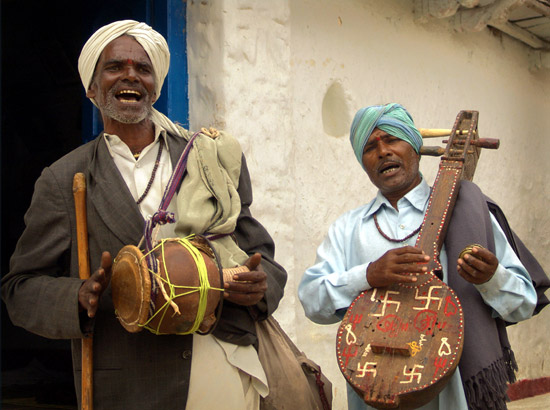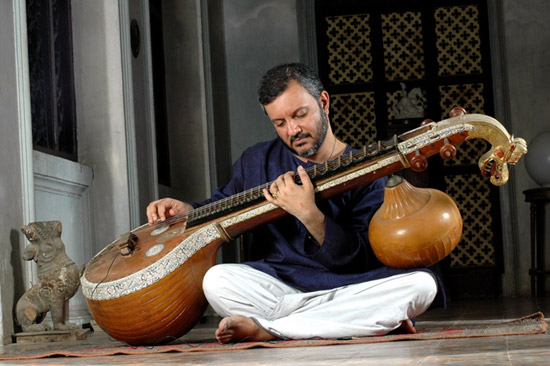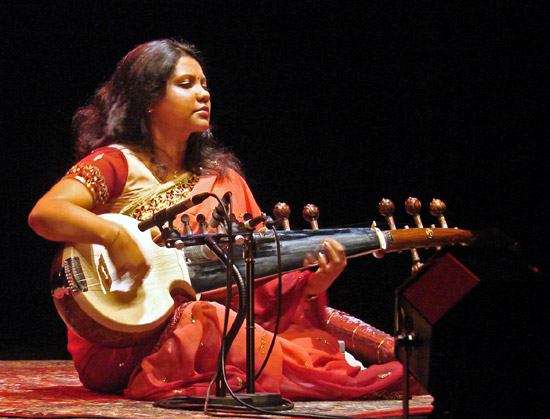Music: Music Overview
The history of Indian music is entwined with the different religious and cultural influences that have swept through the Indian subcontinent over the ages. Music has always been highly revered in India, its origins attributed to divine figures like Naradamuni, Shankar, Brahma, and Saraswati. The traceable history starts with the Indus Valley Civilization (2500–1500 BCE): terracotta and bronze sculptures of musical instruments and dancing figures point to a developed musical culture, although, so far, nothing is known about the type of music prevalent during that period.
Vedic Origins
The religious rituals of the Vedic civilization (1500–500 BCE) incorporated shloka (verse) chanting from the four Vedas: Rigveda, Samaveda, Yajurveda, and Atharvaveda. The samagan hymns from the Samaveda have particular musical significance as they first utilized the sapta swar (seven-note scale) that forms the basis of Indian music. String instruments like the veena and gargar, wind instruments like the venu, bakur, nali, and tunav, and percussion instruments like the dundubhi and talav (tala means rhythm) accompanied the singing.
Correct intonation was emphasized, given the religious significance of the music, but, along with this nibaddh (fixed) music was the anibaddh (free) music, where improvisation was allowed, leading to rich and varied musical interpretations. The Vedic hymns were imparted by pathya shiksha (oral learning) from guru to shishya (student), and, later on, the guru-shishya parampara (tradition) led to the development of the gharana system of musical families, with each musical dynasty following a particular style.
Celestial Beings and Vernacular Folk
In the post-Vedic age (500–200 BCE), there were two main music traditions, the classical—known in Sanskrit variously as maarg (path), gandharva (celestial beings proficient in music), shastriya (classical), and abhijatya (innate)—and the desi (folk), performed in vernacular languages. Musical styles, techniques, instruments, and performances are mentioned in the Ramayana and Mahabharata epics, the Buddhist Jataka tales, and the Jain texts Sthanangsootra and Rayappasenaijja, and artistic depictions of musicians occur in temples, caves, and palm-leaf manuscripts.
Dancing Milkmaids and the Codification of Principles
The Harivamsha (Life of Krishna) treatise (200 BCE–500 CE) describes Krishna and the gopis (milkmaids) performing chhalikya music and hallisaka circle dances. Bharatmuni’s Natyashastra (200 BCE–300 CE) defines music principles, particularly the tala (rhythms), rasa (aesthetics of emotional responses), and bhava (aesthetics of moods) theories, and classifies instruments, expounding on playing techniques.
During the Gupta period (320–600 CE), the technical and aesthetic merits of music are frequently alluded to in the works of Kalidasa and Vatsyayana, and also in the Puranas, the Panchatantra, and the Dattilam. Jati-gayan was the prevalent musical style, and the jatis (classes), although not open to improvisation, facilitated raga development later.
Ocean of Music
The Chinese travelers Fa-Hsien and Hieun-Tsang both mention musical performances held in the temple courtyards and in the royal court, and musical descriptions occur in the literary works of Harshavardhana (606–647 CE). Matanga’s Brihaddeshi discusses the concepts of raga, sargam, shruti, and desi music. Locanakavi’s Ragatarini (1160) describes 12 basic ragas and 86 derivatives, and the verses in Jayadeva’s Gita Govinda have specific talas (regular rhythms). Sarangadeva (1210–1247) and his contemporary Parsvadeva wrote, respectively, the Sangeet-Ratnakara (Ocean of Music) and the Sangeet-Samayasara (Soul-Essence Music); the former detailed 264 ragas (melodic patterns) and outlined a notational system.
Chants of Devotion
The advent of Islam introduced Persian, Arabic, and Afghan elements into Indian music. The Sufi poet Amir Khusro (1253–1325) was particularly influential, and is credited with developing the qawwali, ghazal, naqsh, and tarana styles. The dhrupad and dhamar styles, the bhajans of the Bhakti (Hindu Revivalist) movement, the Ashtachap Sangeet of the Rudra Samparadaya sect, and the Haveli Sangeet of the Pushti Margi Sampradaya sect used regional languages like Brajbhasha and Avadhi, and became popular across different social strata.
Princely Patronage
Sophisticated darbar music developed in the Rajput, Bijapuri, Moghul, and other princely courts of North India beginning in the 15th century, integrating influences from the Persian (Timurid) origins of the Moghuls. The prowess of the incomparable Tansen (1506–1589) with Raga Deepak and Raga Malhar was said to bring about fire and rain, respectively. On a more mundane level, Tansen is credited with improving the Central Asian rubab, which eventually developed into the sarod, as well as composing foundational ragas and systematizing much of the music. Sadarang (Niyamat Khan), a musician in Muhammad Shah Rangile’s court, invented the khayal, and Nawab Wajid Ali Shah of Awadh was a renowned patron of the thumri. Musical patronage declined in British India in the 19th century, and the gharana system strengthened.
Through the Ages
From the turn of the 20th century onward, modern Indian music owes a debt to Pandit Vishnu Narayana Bhatkhande and Pandit Vishnu Digambar Paluskar, who, separately and systematically, organized the different strands of regional music, wrote extensively on musical theories, invented notational systems, and established musical colleges. Classical and folk music to a large extent influenced film and theater music in the earlier years and, later, Western musical influences began to make their mark.
Article written for World Trade Press by Sonal Panse.
Copyright © 1993—2025 World Trade Press. All rights reserved.

 India
India 

